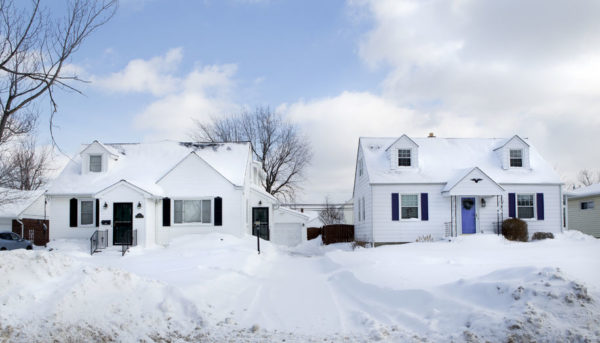
Cold winter weather can wreak havoc on the plumbing system in your Columbus, Ohio home, especially if it’s not prepared. As outside temperatures plummet, you want to make sure that your pipes, exterior faucets, and other plumbing features are well-protected. Following are eight tips to help you get started.
1. Find and Fix All Slow and Hidden Plumbing Leaks
Even if they aren’t a huge bother to you right now, slow and hidden plumbing leaks are guaranteed to wreak havoc on your property over time. Slow and hidden leaks increase the amount of moisture in the indoor air and set the stage for mold problems. They also diminish the integrity of all building materials that surround them by causing wood rot, discoloration, mildew, and more. These are often small leaks that are hidden behind drywall or found at the backs of appliances. The best way to locate them is by scheduling a whole-house plumbing inspection.
When water from leaky pipes freezes and expands, it can increase the size and magnitude of leaks. If you have loose or damaged connections at the backs of your appliances, frozen water here can damage them. Taking care of these issues ahead of any major drop in outside temperatures will keep them from spiraling out of control.
2. Set Your Thermostat at a Moderate Temperature and Keep It There
The best way to protect the plumbing in the interior of your home is by keeping your living environment at a reasonable temperature all of the time. If your living space isn’t freezing, your indoor pipes won’t freeze. In fact, maintaining adequately high temperatures in the interior home can also prevent pipes at your perimeter walls from freezing as well. It does so by providing enough warmth to keep their temperatures higher than the temperature outdoors.
If you choose to leave home during winter to take a holiday vacation or other extended trip, you should turn your plumbing off and clear all residual water out of the plumbing lines before leaving. You can also schedule plumbing service before heading out and have a professional thoroughly winterize your plumbing instead.
3. Seal Off or Insulate Your Crawl Spaces
Given that heat rises and that most basement areas aren’t serviced by home heating systems, plumbing in these spaces is incredibly vulnerable to chilly wintertime temperatures. An easy way to protect these features is by sealing off your crawl spaces so that cold air can’t get in. Some homeowners do this with cardboard and duct tape, and others use small squares of drywall that have been cut to fit. However, a far more effective and long-term solution is having your crawl spaces professionally insulated. The costs of crawl space insulation are more than worthwhile given the considerable property damage this home improvement project can prevent.
Crawl space insulation:
- Makes homes more energy efficient by limiting heat loss
- Prevents the ingress of cold air
- Serves as an important waterproofing measure for moderate rainfall and snow melt
More importantly, crawl space insulation prevents pipes in these low-lying areas of the home from freezing and rupturing. When adding insulation to your crawl spaces, check your attic to see if it needs more insulation as well. Increasing your attic insulation or upgrading to insulation with a higher R-value will keep your home warmer and minimize the risk of freezing pipes in all areas.
4. Insulate Your Exterior Pipes
Walk around the exterior of your home and look for any pipes that are completely exposed. Exposed pipes on the property’s exterior should all be insulated before the temperature drops. This is another task that a plumbing professional can handle for you. However, it is also one that many homeowners can take care of themselves. Simply measure the diameter and length of each exposed pipe. Then, purchase insulating sleeves that can accommodate these dimensions at your local home improvement store.
Insulating sleeves are long and tubular. Your supplier can use your recorded dimensions to cut these tubes to fit, or you can cut them yourself. Insulating sleeves also have a deep seam along their sides. This can be pulled apart to open the sleeves up. Once opened, these sleeves can be slipped over exposed pipes and affixed in place with zip ties or rubber insulation tape. If you have exposed plumbing in your garage, you should insulate this too. You can also add insulation to your garage door or to the entire garage. Plumbing in indoor areas that aren’t serviced by any fixed, permanent heating solution must receive insulation or another form of reliable cold-weather protection.
5. Have Your Water Heater Flushed
Don’t overlook your water heater when winterizing your home’s plumbing. After all, you’ll definitely want access to hot water when the temperatures drop. Nothing is worse than having to muscle your way through cold baths or showers when the outside temperatures are already frosty. If you haven’t done so in a while, schedule an appointment to have your water heater flushed. This will remove all sediment from this unit so that it’s unlikely to experience problems when subjected to the added stress of cold weather.
6. Disconnect All Hoses at the Building Exterior and Install Hose Bib Covers
Don’t leave water hoses connected to your outdoor spigots. Residual water in these hoses can freeze, expand, and back up into your pipes. At the very least, this will damage your water hoses and faucets. At worst, it can leave you with a major indoor flood to deal with.
After you’ve removed your hoses, hang them over your fence or another elevated surface and let them dry. When all of their water has drained out, you can wipe them down and store them in a warm place such as your basement or outdoor shed. Turn the water to your outdoor spigots off at the supply line. Finally, cover your hose bibs with insulating covers.
7. Install Heat Cables
Heat cables are an excellent innovation for preventing wintertime plumbing issues. In fact, many homeowners are also installing these products in their gutters. They’re great for preventing problems with ice damming at the roof, frozen pipes, and frozen supply lines. You can use heat cables in your garage, along your exterior plumbing, and on all plumbing in your crawl spaces. Heat cables are an effective added measure against freezing. If you’ve never used or installed heat cables before, have your plumber put them in for you.
8. Seal Up Air Leaks at All Rim Joists
Most of your efforts to winterize your home’s plumbing will also benefit your HVAC system. Sealing up air leaks in attics, crawl spaces, basements, and other areas will limit the amount of work that your heater has to do to keep everyone warm. As a result, you’ll spend less on your monthly heating bills during winter, and you’ll also extend the lifespan of your boiler, furnace, or heat pump.
Rim joists are a common source of heat loss throughout the building. These are the areas where wood framing directly abuts the floor joists. Rim joists wrap around the entire perimeter of the floor’s framing. Head down to your basement with a step ladder and a tube of caulk or some expandable foam to fill these in. You should also seal off any gaps, cracks, or holes in areas where cabling and wires enter the building. Once this work is done, you’ll have an airtight home and sufficient indoor heat for preventing all cold-related plumbing issues.
At Apex Plumbing, we proudly serve residents of Columbus, Ohio and the surrounding areas. We offer plumbing installation, maintenance, and repair services. We also provide gas leak detection, bathroom remodeling, and slab leak repairs. If you need help winterizing the plumbing in your home, give us a call today.





